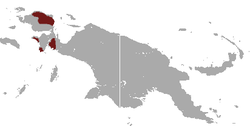| Ursine tree-kangaroo [1] | |
|---|---|
 | |
| Scientific classification | |
| Kingdom: | Animalia |
| Phylum: | Chordata |
| Class: | Mammalia |
| Infraclass: | Marsupialia |
| Order: | Diprotodontia |
| Family: | Macropodidae |
| Genus: | Dendrolagus |
| Species: | D. ursinus |
| Binomial name | |
| Dendrolagus ursinus (Temminck, 1836) | |
 | |
| Ursine tree-kangaroo range | |
The ursine tree-kangaroo (Dendrolagus ursinus) is a long-tailed, furry, bear-like mammal found only in tropical forests on the island of New Guinea (in Indonesia). Slightly larger than a cat, it lives alone in trees and is active at night to feed on leaves and fruit. It belongs to the macropod family (Macropodidae) with kangaroos, and carries its young in a pouch like other marsupials. It has a small range in northwestern New Guinea and is threatened by habitat loss and hunting. Other common names for this species include the black tree-kangaroo, the Vogelkop tree-kangaroo and the white-throated tree-kangaroo. [2]
